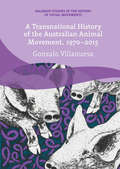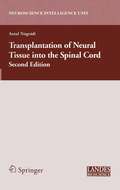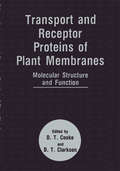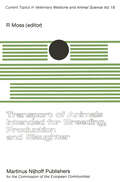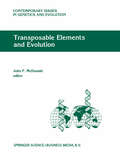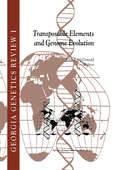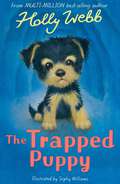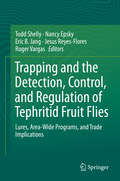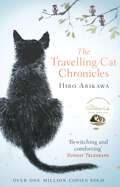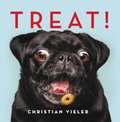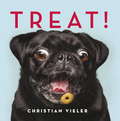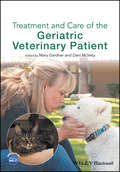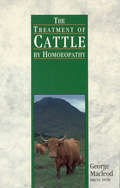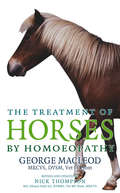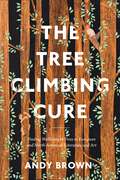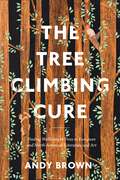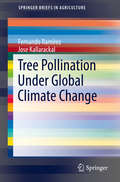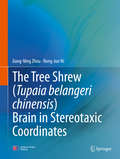- Table View
- List View
A Transnational History of the Australian Animal Movement, 1970-2015
by Gonzalo VillanuevaThis book offers the first transnational historical study of the creation, contention and consequences of the Australian animal movement. Largely inspired by Peter Singer and his 1975 book Animal Liberation, a new wave of animal activism emerged in Australia and across the world. In an effort to draw public and media attention to the plight of animals, such as the rearing of pigs and poultry in factory farms and the export of live animals to the Middle East and South East Asia, Australian activists were often innovative and provocative in how they made their claims. Through lobbying, disruptive methods, and vegan activism, the animal movement consistently contested the politics and culture of how animals were used and exploited. Australians not only observed and learnt from people and events overseas, but also played significant international roles. This book examines the complex and conflicting consequences of the animal movement for Australian politics, as well as its influence on broader social change.
Transplantation of Neural Tissue into the Spinal Cord (Neuroscience Intelligence Unit)
by Antal NogradiThe book gives an account of results obtained from experiments where grafts of neuronal, glial and other tissues as well as artificial materials were placed into the spinal cord. It attempts to evaluate the contributions made by these studies to our understanding of basic neurobiologies questions. These include factors that regulate neuronal growth during development as well as regenera tion following injury to the nervous system. The model of neural transplanta tion is also useful for the study of cell-to-cell interactions, and this applies to interactions between glial cells and neurones, between various populations of neuronal cells and finally between axons and skeletal muscle fibres. The mecha nisms involved in the establishment of specific synaptic connections between neurones can also be investigated in this experimental paradigm. Important in formation regarding this issue was also obtained on systems other than the spinal cord, i. e. the cerebellum, hippocampus and striatum. Although such in formation of precise connections between the host and the grafted embryonic tissue is still lacking in the spinal cord, there is much information on the re sponse of the host nervous system to the grafted embryonic tissue, and that of the graft to its new host environment. It appears that embryonic grafts are able to induce repair processes follow ing injury to the nervous system.
Transport and Receptor Proteins of Plant Membranes: Molecular Structure and Function
by D. T. Clarkson D. T. CookeTransport of Animals Intended for Breeding, Production and Slaughter: A Seminar in the CEC Programme of Coordination of Research on Animal Welfare, organised by R. Moss, and held in Brussels, 7–8 July, 1981 (Current Topics in Veterinary Medicine #18)
by R. MossThe transport of farm livestock was the subject of the seminar held from 7 - 8 July 1981 at the Commission of the European Communities (CECl, Directorate General for Agriculture, Brussels as part of the work of the Division Coordinating Agricultural Research. The aims of the seminar were to examine the knowledge available on how the physiology and behaviour of animals may change during transport; to consider the significance of these changes in relation to welfare and economics and to assess those actions which as experimental projects or observational studies might be proposed to fill the most important gaps in our knowledge of the welfare of farm animals during transport. A number of conclusions can be drawn from the proceedings: 1. Much knowledge is available from both scientific observations and practical experience which could be used to improve the transport of livestock. Methods of loading, the construction of vehicles, ships, crates and aircraft could benefit from the application of existing knowledge. It is less clear whether it is best to concentrate on disseminating existing knowledge by education and advice or to contemplate more regulations. 2. Losses by down-grading at slaughter can largely be attributed to the ways in which animals are transported and handled.
Transposable Elements and Evolution (Contemporary Issues in Genetics and Evolution #1)
by J. F. McDonaldIn the summer of 1992 a distinguished group of molecular, population and evolutionary geneticists assembled on the campus of the University of Georgia in Athens, USA to discuss the relevance of their research to the role played by transposable elements (TEs) in evolution. The meeting consisted of a series of informal discussions of issues brought up in papers written by the participants and distributed among them prior to the meeting. These papers and the transcripts of the ensuing discussions are presented in this volume.
Transposable Elements and Genome Evolution (Georgia Genetics Review #1)
by J. F. McDonaldOnce considered merely `selfish' or `parasitic' DNA, transposable elements are today recognized as being of major biological significance. Not only are these elements a major source of mutation, they have contributed both directly and indirectly to the evolution of genome structure and function. On October 8-10, 1999, 100 molecular biologists and evolutionists representing 11 countries met on the campus of The University of Georgia in Athens for the inaugural Georgia Genetics Symposium. The topics of presentations ranged from how the elements themselves have evolved to the impact transposable elements have had on the evolution of their host genomes. The papers in this volume therefore represent state-of-the-art thinking, by leading world experts in the field, on the evolutionary significance of transposable elements.
Transylvanian Dinosaurs
by David B. Weishampel Coralia-Maria JianuAt the end of the time of the dinosaurs, Transylvania was an island in what was to become southeastern Europe. The island's limited resources affected the size and life histories of its animals, resulting in a local dwarfism. For example, sauropods found on the island measured only six meters long, while their cousins elsewhere grew up to five times larger. Here, David B. Weishampel and Coralia-Maria Jianu present unique evolutionary interpretations of this phenomenon. The authors bring together the latest information on the fauna, flora, geology, and paleogeography of the region, casting these ancient reptiles in their phylogenetic, paleoecological, and evolutionary contexts. What the authors find is that Transylvanian dinosaurs experienced a range of unpredictable successes as they evolved.Woven throughout the detailed history and science of these diminutive dinosaurs is the fascinating story of the man who first discovered them, the mysterious twentieth-century paleontologist Franz Baron Nopcsa, whose name is synonymous with Transylvanian dinosaurs. Hailed by some as the father of paleobiology, it was Nopcsa alone who understood the importance of the dinosaur discoveries in Transylvania; their story cannot be told without recounting his.Transylvanian Dinosaurs strikes an engaging balance between biography and scientific treatise and is sure to capture the imagination of professional paleontologists and amateur dinophiles alike.
Transylvanian Dinosaurs
by David B. Weishampel Coralia-Maria JianuAt the end of the time of the dinosaurs, Transylvania was an island in what was to become southeastern Europe. The island's limited resources affected the size and life histories of its animals, resulting in a local dwarfism. For example, sauropods found on the island measured only six meters long, while their cousins elsewhere grew up to five times larger. Here, David B. Weishampel and Coralia-Maria Jianu present unique evolutionary interpretations of this phenomenon. The authors bring together the latest information on the fauna, flora, geology, and paleogeography of the region, casting these ancient reptiles in their phylogenetic, paleoecological, and evolutionary contexts. What the authors find is that Transylvanian dinosaurs experienced a range of unpredictable successes as they evolved.Woven throughout the detailed history and science of these diminutive dinosaurs is the fascinating story of the man who first discovered them, the mysterious twentieth-century paleontologist Franz Baron Nopcsa, whose name is synonymous with Transylvanian dinosaurs. Hailed by some as the father of paleobiology, it was Nopcsa alone who understood the importance of the dinosaur discoveries in Transylvania; their story cannot be told without recounting his.Transylvanian Dinosaurs strikes an engaging balance between biography and scientific treatise and is sure to capture the imagination of professional paleontologists and amateur dinophiles alike.
The Trapped Puppy: 20 (Holly Webb Animal Stories #56)
by Holly WebbRuby loves playing with Toby and can't wait to take him for proper walks – they'll have such fun! But on an outing to the woods, Toby's curious nature gets the better of him and he runs off in search of adventure. Soon the puppy is lost in the woods, frightened and all alone. Will he ever be reunited with his beloved best friend Ruby? From the best-selling author Holly Webb comes another heart-warming animal story.
Trapping and the Detection, Control, and Regulation of Tephritid Fruit Flies: Lures, Area-Wide Programs, and Trade Implications
by Todd Shelly Nancy Epsky Eric B. Jang Jesus Reyes-Flores Roger VargasThe book focuses on four broad topics related to trapping of agriculturally important tephritid fruit flies, namely i) lures and traps, ii) invasion biology and detection of infestations, iii) attract and kill systems, and iv) trade regulations and risk assessment. This comprehensive structure progresses from the biological interaction between insect and lures/traps to the area-wide use of trapping systems to the utilization and impact of trapping data on international trade. The chapters include accounts of earlier research but are not simply compendia and instead evaluate past and current work as a tool for critical analysis and proposal of productive avenues for future work. At present there is no book available that deals with fruit fly trapping in such a broad context. Our book fills this gap and serves as a global reference for both those interested in fruit flies specifically as well as anyone dealing with the threat of invasive agricultural insects in general.
Trapping of Small Organisms Moving Randomly: Principles and Applications to Pest Monitoring and Management (SpringerBriefs in Ecology)
by James R. Miller Christopher G. Adams Paul A. Weston Jeffrey H. SchenkerThis new book is the first to make logical and important connections between trapping and foraging ecology. It develops and describes—both verbally and mathematically--the underlying principles that determine and define trap-organism interactions. More important, it goes on to explain and illustrate how these principles and relationships can be used to estimate absolute population densities in the landscape and to address an array of important problems relating to the use of trapping for detection, population estimation, and suppression in both research and applied contexts. The breakthrough nature of subject matter described has broad fundamental and applied implications for research for addressing important real-world problems in agriculture, ecology, public health and conservation biology. Monitoring traps baited with potent attractants of animals like insects have long played a critical role in revealing what pests are present and when they are active. However, pest managers have been laboring without the tools necessary for quick and inexpensive determination of absolute pest density, which is the cornerstone of pest management decisions. This book spans the gamut from highly theoretical and fundamental research to very practical applications that will be widely useful across all of agriculture.
The Travelling Cat Chronicles: The uplifting million-copy bestselling Japanese translated story
by Hiro ArikawaTHE PERFECT CURL-UP READ FOR CAT LOVERS*** Includes a sneak preview from the author's new bestseller, The Goodbye Cat *** 'Bewitching... as self-possessed and comforting as - well, a cat' SUNDAY TELEGRAPH'A book about kindness and love, and how the smallest things can provide happiness' STYLIST___It's not the journey that counts, but who's at your side.Nana is on a road trip, but he is not sure where he is going. All that matters is that he can sit beside his beloved owner Satoru in the front seat of his silver van.Satoru is keen to visit three old friends from his youth, though Nana doesn't know why and Satoru won't say.Set against the backdrop of Japan's changing seasons and narrated with a rare gentleness and humour, Nana's story explores the wonder and thrill of life's unexpected detours. It is about the value of friendship and solitude, and knowing when to give and when to take.At the heart of this book is a powerful message about the importance of kindness. It shows, above all, how acts of love, both great and small, can transform our lives.___Readers love THE TRAVELLING CAT CHRONICLES:'Delightful, insightful, full of warmth with plenty of humour' 5 stars *****'Uplifting and heart wrenching in equal measure' 5 stars *****'It had me in floods of tears but filled me with hope too' 5 stars *****
The Travelling Vet: From pets to pandas, my life in animals
by Jonathan CranstonJonathan Cranston is no ordinary vet. In addition to his day job in the Gloucestershire countryside treating cows, dogs, pigs and cats, he's also worked with an astonishing range of species around the world, including crocodiles, rhinos and pandas. In this charming collection he introduces us to some of his favourite patients, ranging from beloved family pets through to magnificent creatures of the wild. Whether microchipping armadillos, anaesthetising giraffes or birthing a calf, Jonathan's love for his work and the entire animal kingdom is infectious. From the preposterous (castrating a sugar glider) to the poignant (encountering victims of rhino poaching), the stories in The Travelling Vet will delight and enthral every animal lover.
Treat!: Dogs Catching Treats: The Funniest Dog Book Of The Year
by Christian VielerThis adorable and hilarious collection of dog photographs captures our furry best friends anticipating, catching -- some more successfully than others -- and enjoying a scrumptious tidbit. Photographer Christian Vieler caught dozens of eager dogs at one of their favorite moments--treat time. From a tenacious terrier to a goofy golden retriever, these often hilarious and surprisingly beautiful photographs capture each dog's unique personality in a way any dog owner will recognize and that all dog lovers will enjoy!
Treat!: DOGS CATCHING TREATS: THE FUNNIEST DOG BOOK OF THE YEAR
by Christian VielerAs seen in the Daily Mail, the Times and the Telegraph Who's a good dog?Photographer Christian Vieler caught these eager dogs anticipating, catching, and enjoying a scrumptious tidbit - some more successfully than others.From a tenacious terrier to a goofy golden retriever, these often hilarious and surprisingly beautiful photographs capture each dog's unique personality in a way any dog owner will recognize and that all dog lovers will enjoy!
Treatise on Acoustics: The First Comprehensive English Translation of E.F.F. Chladni's Traité d’Acoustique
by E.F.F. ChladniE.F.F. Chladni’s experiments and observations with sound and vibrations profoundly influenced the development of the field of Acoustics. The famous Chladni diagrams along with other observations are contained in Die Akustik, published in German in 1802 and Traité d’Acoustique, a greatly expanded version, published in French in 1809. This is the first comprehensive translation of the expanded French version of Traité d’Acoustique, using the 1802 German publication for reference and clarification. The translation was undertaken by Robert T. Beyer, PhD (1920-2008), noted acoustician, Professor of Physics at Brown University, and Gold Medal recipient of the Acoustical Society of America. Along with many other projects completed over the course of his career, Dr. Beyer translated Von Neumann’s seminal work, Mathematical Foundations of Quantum Mechanics from the original German, spent 30 years translating Russian physics treatises and journals, served as editor of the English translation of the Soviet Journal of Experimental and Theoretical Physics, and also authored Sounds of our Times: Two Hundred Years of Acoustics.
Treatment and Care of the Geriatric Veterinary Patient
by Mary Gardner Dani McVetyTreatment and Care of the Geriatric Veterinary Patient offers veterinarians a complete guide to treating and managing geriatric canine and feline patients. Offers practical guidance on managing all aspects of veterinary care in geriatric pets Takes a holistic approach to managing the geriatric patient, from common diseases and quality of life to hospice, euthanasia, client communications, and business management Focuses on dogs and cats, with a chapter covering common exotic animals Provides clinically oriented advice for ensuring quality of life for older pets Includes access to a companion website with videos, client education handouts, and images
Treatment and Care of the Geriatric Veterinary Patient
by Mary Gardner Dani McVetyTreatment and Care of the Geriatric Veterinary Patient offers veterinarians a complete guide to treating and managing geriatric canine and feline patients. Offers practical guidance on managing all aspects of veterinary care in geriatric pets Takes a holistic approach to managing the geriatric patient, from common diseases and quality of life to hospice, euthanasia, client communications, and business management Focuses on dogs and cats, with a chapter covering common exotic animals Provides clinically oriented advice for ensuring quality of life for older pets Includes access to a companion website with videos, client education handouts, and images
The Treatment Of Cattle By Homoeopathy
by George MacleodMany farmers today are concerned, not only with the increasing cost of conventional drugs, but also with their side-effects and the build-up of resistant strains of bacteria due to the continued and often indiscriminate use of antibiotics.While this book will appeal to the already converted it is hoped that the unprejudiced newcomer will be sufficiently encouraged to investigate this system of medicine and enjoy its undoubted benefits.The aim of the homeopathic approach is to build up the health of the herd and increase the resistance of its individual members to disease, and, in consequence to increase the milk output and quality.Homeopathic remedies are all derived from natural sources and George Macleod outlines the homeopathic approach to the commoner diseases of cattle, omitting only serious injuries and others which are not economic to treat.
The Treatment Of Horses By Homoeopathy
by George MacleodThis book is for anyone who is interested in the welfare of horses, and who wishes to know more about treating them with homoeopathic remedies. Increasing numbers of horse owners and handlers today confirm that homoeopathy is a speedy and effective treatment, which can often deal with so-called 'incurable' ailments. As this fascinating guide explains, homoeopathic remedies are absolutely safe, easy to administer and have no side effects. This authoritative book includes advice on treating horses homoeopathically for both specific diseases and common ailments.
The Tree Climbing Cure: Finding Wellbeing in Trees in European and North American Literature and Art (Environmental Cultures)
by Andy BrownOur relationship with trees is a lengthy, complex one. Since we first walked the earth we have, at various times, worshiped them, felled them and even talked to them. For many of us, though, our first memories of interacting with trees will be of climbing them.Exploring how tree climbers have been represented in literature and art in Europe and North America over the ages, The Tree Climbing Cure unpacks the curative value of tree climbing, examining when and why tree climbers climb, and what tree climbing can do for (and say about) the climber's mental health and wellbeing.Bringing together research into poetry, novels, and paintings with the science of wellbeing and mental health and engaging with myth, folklore, psychology and storytelling, Tree Climber also examines the close relationship between tree climbing and imagination, and questions some longstanding, problematic gendered injunctions about women climbing trees. Discussing, among others, the literary works of Margaret Atwood; Charlotte Bronte; Geoffrey Chaucer; Angela Carter; Kiran Desai; and J.R.R. Tolkien, as well as work by artists such as Peter Doig; Paula Rego; and Goya, this book stands out as an almost encyclopedic examination of cultural representations of this quirky and ultimately restorative pastime.
The Tree Climbing Cure: Finding Wellbeing in Trees in European and North American Literature and Art (Environmental Cultures)
by Andy BrownOur relationship with trees is a lengthy, complex one. Since we first walked the earth we have, at various times, worshiped them, felled them and even talked to them. For many of us, though, our first memories of interacting with trees will be of climbing them.Exploring how tree climbers have been represented in literature and art in Europe and North America over the ages, The Tree Climbing Cure unpacks the curative value of tree climbing, examining when and why tree climbers climb, and what tree climbing can do for (and say about) the climber's mental health and wellbeing.Bringing together research into poetry, novels, and paintings with the science of wellbeing and mental health and engaging with myth, folklore, psychology and storytelling, Tree Climber also examines the close relationship between tree climbing and imagination, and questions some longstanding, problematic gendered injunctions about women climbing trees. Discussing, among others, the literary works of Margaret Atwood; Charlotte Bronte; Geoffrey Chaucer; Angela Carter; Kiran Desai; and J.R.R. Tolkien, as well as work by artists such as Peter Doig; Paula Rego; and Goya, this book stands out as an almost encyclopedic examination of cultural representations of this quirky and ultimately restorative pastime.
Tree of Origin: What Primate Behavior Can Tell Us about Human Social Evolution
by F. B. WaalHow did we become the linguistic, cultured, and hugely successful apes that we are? Our closest relatives--the other mentally complex and socially skilled primates--offer tantalizing clues. In Tree of Origin nine of the world's top primate experts read these clues and compose the most extensive picture to date of what the behavior of monkeys and apes can tell us about our own evolution as a species. It has been nearly fifteen years since a single volume addressed the issue of human evolution from a primate perspective, and in that time we have witnessed explosive growth in research on the subject. Tree of Origin gives us the latest news about bonobos, the "make love not war" apes who behave so dramatically unlike chimpanzees. We learn about the tool traditions and social customs that set each ape community apart. We see how DNA analysis is revolutionizing our understanding of paternity, intergroup migration, and reproductive success. And we confront intriguing discoveries about primate hunting behavior, politics, cognition, diet, and the evolution of language and intelligence that challenge claims of human uniqueness in new and subtle ways. Tree of Origin provides the clearest glimpse yet of the apelike ancestor who left the forest and began the long journey toward modern humanity.
Tree Pollination Under Global Climate Change (SpringerBriefs in Agriculture)
by Fernando Ramírez Jose KallarackalThis brief reviews the pollination aspects of both wild and domesticated fruit tree species in a global climate change context. It explores cross-pollination mediated by insects, vertebrates and abiotic factors, self-pollination and their global warming implications. The authors identify the link between abiotic factors such as precipitation and severe droughts in the context of tree pollination and climate change. Furthermore, pollination and conservation implications in agriculture as well as wild tree populations are explored. Emphasis has been given to fruit trees growing in tropical, subtropical and temperate environments.
The Tree Shrew (Tupaia belangeri chinensis) Brain in Stereotaxic Coordinates
by Jiang-Ning Zhou Rong-Jun NiThis atlas is currently the most systematic and comprehensive atlas of the tree shrew brain. The purpose of this book is to help scientists acquire accurate coordinates of the brain regions of the tree shrew, which is becoming a popular animal model for a variety of human diseases. This atlas contains series of 192 coronal sections, 36 sagittal sections, and 49 horizontal sections using Nissl staining or acetylcholinesterase histochemistry as well as a series of diagrams in stereotaxic coordinates. Original photomicrographs are obtained at single-cell resolution. In addition, we also referred to magnetic resonance images acquired at 250 um intervals with a magnetic resonance scanner 9.4T. Many brain structures are first identified in tree shrews and accurately presented in a stereotaxic coordinate system. The Bregma coordinates system is used for the first time in this tree shrew brain atlas. The atlas represents the collaboration between two indispensable skills of brain research, neuroanatomy and stereotaxic surgery. It will be extensively used in neuroscience research, particularly tree shrew brain study, and will help graduate students and researchers understand brain anatomy and acquire accurate reference coordinates.
